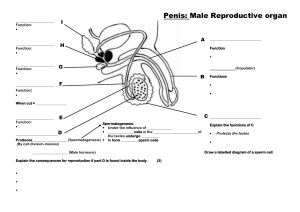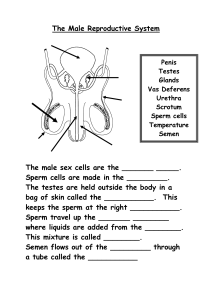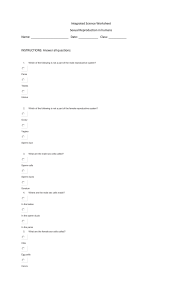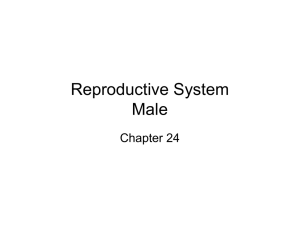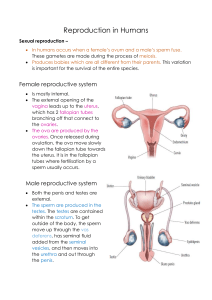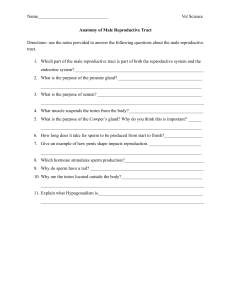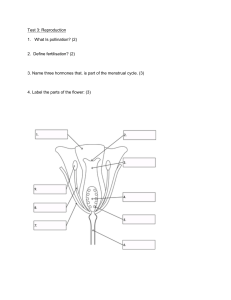Male Reproductive System: Anatomy & Spermatogenesis
advertisement
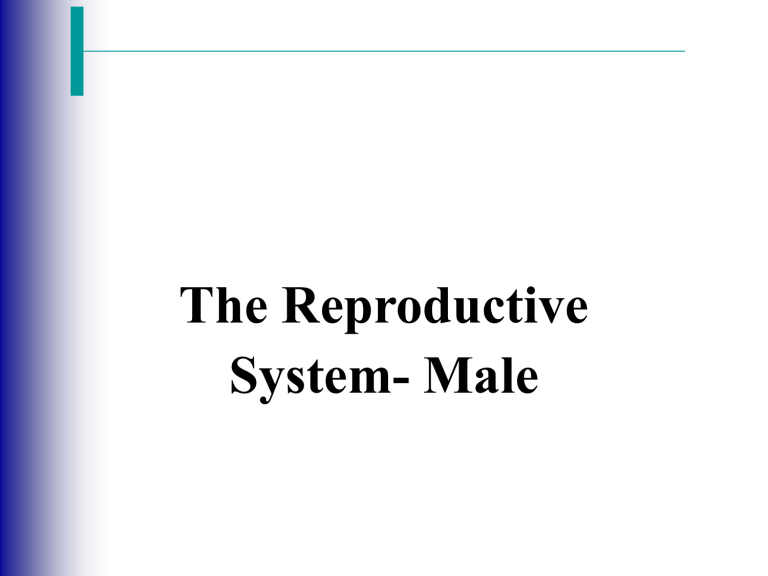
The Reproductive System- Male The Reproductive System Gonads – primary sex organs Testes in males Ovaries in females Gonads produce gametes (sex cells) and secrete hormones Sperm – male gametes Ova (eggs) – female gametes Developmental Aspects of the Reproductive System Gender is determined at fertilization Males have XY sex chromosomes Females have XX sex chromosomes Gonads do not begin to form until the eighth week Developmental Aspects of the Reproductive System Testes form in the abdominal cavity and descend to the scrotum one month before birth The determining factor for gonad differentiation is testosterone Developmental Aspects of the Reproductive System Reproductive system organs do not function until puberty Puberty usually begins between ages 10 and 15 The first menses usually occurs about two years after the start of puberty Most women reach peak reproductive ability in their late 20s Developmental Aspects of the Reproductive System Menopause occurs when ovulation and menses cease entirely Ovaries stop functioning as endocrine organs There is a no equivalent of menopause in males, but there is a steady decline in testosterone Male Reproductive System Male Reproductive System Testes Duct system Epididymis Ductus deferens Urethra Male Reproductive System Accessory organs Seminal vesicle Prostate gland Bulbourethral gland External genitalia Penis Scrotum Testes Coverings of the testes Tunica albuginea – capsule that surrounds each testis Testes Coverings of the testes (continued) Septa – extensions of the capsule that extend into the testis and divide it into lobules Testes Each lobule contains one to four seminiferous tubules Tightly coiled structures Function as spermforming factories Empty sperm into the rete testis Sperm travels through the rete testis to the epididymis Interstitial cells produce testosterone Interstitial cells: produce testosterone Sertoli cells ( nurse cells ) support sperm production. Epididymis Comma-shaped, tightly coiled tube Found on the superior part of the testis and along the posterior lateral side Functions to mature and store sperm cells (at least 20 days) Expels sperm with the contraction of muscles in the epididymis walls to the vas deferens (ductus deferens) Male Reproductive System Ductus Deferens (Vas Deferens) Carries sperm from the epididymis to the ejaculatory duct Passes through the inguinal canal and over the bladder Moves sperm by peristalsis Spermatic cord – ductus deferens, blood vessels, and nerves in a connective tissue sheath Ductus Deferens (Vas Deferens) Ends in the ejaculatory duct which unites with the urethra Vasectomy – cutting of the ductus deferens at the level of the testes to prevent transportation of sperm Spermatic Cord and Inguinal Canal Contents of Spermatic cord: Cremasteric muscleadjusts testes to control temperature Testicular ( gonadal) artery Ductus deferens Nerves Veins Development and descent of testes and formation of spermatic cord. A: Two months in utero. B: Three months in utero. C: At birth. Urethra Extends from the base of the urinary bladder to the tip of the penis Carries both urine and sperm Sperm enters from the ejaculatory duct Urethra Regions of the urethra Prostatic urethra – surrounded by prostate Membranous urethra – from prostatic urethra to penis Spongy (penile) urethra – runs the length of the penis Seminal Vesicles Located at the base of the bladder Produces a thick, yellowish secretion (60% of semen) Fructose (sugar) Vitamin C Prostaglandins Other substances that nourish and activate sperm Prostate Gland Encircles the upper part of the urethra Secretes a milky fluid Helps to activate sperm Enters the urethra through several small ducts Bulbourethral Glands Pea-sized gland inferior to the prostate Produces a thick, clear mucus Cleanses the urethra of acidic urine Serves as a lubricant during sexual intercourse Secreted into the penile urethra Semen Mixture of sperm and accessory gland secretions Advantages of accessory gland secretions Fructose provides energy for sperm cells Alkalinity of semen helps neutralize the acidic environment of vagina Semen inhibits bacterial multiplication Elements of semen enhance sperm motility External Genitalia Scrotum Divided sac of skin outside the abdomen Maintains testes at 3°C lower than normal body temperature to protect sperm viability External Genitalia Penis Delivers sperm into the female reproductive tract Regions of the penis Shaft Glans penis (enlarged tip) Prepuce (foreskin) Folded cuff of skin around proximal end Often removed by circumcision External Genitalia Internally there are three areas of spongy erectile tissue around the urethra Spermatogenesis Production of sperm cells Begins at puberty and continues throughout life Occurs in the seminiferous tubules Processes of Spermatogenesis Spermatogonia (stem cells) undergo rapid mitosis to produce more stem cells before puberty Follicle stimulating hormone (FSH) modifies spermatogonia division One cell produced is a stem cell The other cell produced becomes a primary spermatocyte Processes of Spermatogenesis Primary spermatocytes undergo meiosis Haploid spermatids are produced Processes of Spermatogenesis Spermiogenesis Late spermatids are produced with distinct regions Head – contains DNA covered by the acrosome Midpiece Tail Sperm cells result after maturing of spermatids Spermatogenesis takes 64 to 72 days The acrosome contains digestive enzymes to penetrate the outer covering of the egg Mitochondria produce energy from secretions which is used to move the flagellum Match the following: A. B. C. D. E. Interstitial Cells Nurse cells Seminiferous Tubules Epididimys Spermatic cord 1. 2. 3. 4. 5. Contains testicular artery, nerves, ductus deferens Support sperm formation Produce testosterone Site of sperm formation Site of sperm maturation. Conversion of haploid spermatids to spermatozoa is specifically called __________. A. B. C. D. mitosis meiosis spermatogenesis spermiogenesis The area of the sperm cell that contains many mitochondria is the __________. A. Midpiece ( or middle piece) B. acrosome C. tail D. head _________ acts upon the __________ to encourage the release of follicle-stimulating hormone (FSH) and luteinizing hormone (LH). A. Gonadotropin-releasing hormone (GnRH); Sertoli (nurse)cells B. Testosterone; anterior pituitary C. Testosterone; Sertoli (nurse) cells D. Gonadotropin-releasing hormone (GnRH); anterior pituitary
